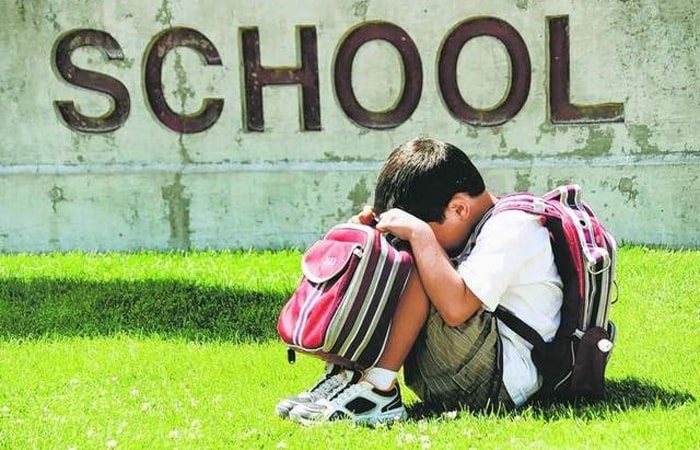Back to school can bring up anxiety for kids. For children and teens with social anxiety, back to school can be particularly challenging. Social anxiety disorder in kids is characterized by fear of social situations with peers in which they may be judged negatively and in which their peers may notice their anxiety leading to rejection, embarrassment or other negative outcomes. The anxiety must be present for at least 6 months and create distress and/or difficulty functioning.
Common anxious thoughts kids may have about back-to-school are:
• “Will I make friends?”
• “Will I have anyone to sit with at lunch or play with at recess?”
• “I don’t want to go.”
Common physical sensations on the first day of school or the days leading up the first day of school are:
• Sadness and/or irritability
• Crying, tantrums or tearfulness
• Lack of appetite and/or nausea
• Headaches
• Difficulty sleeping or nightmares
Common behaviors leading up to school may include:
• Avoiding talking about school or preparing for school
• Avoiding back to school events
• Withdrawing into their room
• Avoidance through more desire for screen time
If your child or adolescent is experiencing these symptoms, here are some ways to help ease their transition back to school:
Role Play with Your Child
Practice different scenarios with your child that will likely arise in the first days of a new school year. For example, your child can practice how to make eye contact, smile and say hi. They can practice introducing themselves to the student next to them or, if they are really feeling brave, ask a get-to-know-you question such as: “What did you do this summer?” or “Do you know anything about this teacher (or this class?).” They can even practice complimenting the other student on their shirt or backpack to strike up a conversation. If there are other family members available to practice role playing, get them involved as well. The more your anxious kid can practice, the more confident they will be in themselves.
Don’t Let Your Child Avoid

While it’s common for kids (and all of us) to want to avoid things that create anxiety, make sure to attend events with your child leading up to the start of school such as playground meet ups and classroom meet and greets the week before school starts.
Start transitioning your child to their new school wake up time (if different from summer wake up time) 1-2 weeks prior to the start of school. Organize and discuss with your child the back-to-school materials, clothes, schedules, and plans for breakfasts and school lunches well in advance of the first day. Allow extra time the first few mornings of school in case there are unexpected issues that arise or tears. Having extra time built in for a potential meltdown, traffic in the car line or for something else unexpected is key.
Do a dry run, if possible! Go to the school a few days prior to the start date. Walk around, check out the playground, go inside (if possible), and say hello to any staff or teachers who are around. This is a great option to help kids have a vision for how the first day is going to go.
Practice Calming Breathing
Help your kids calm their body’s stress response through diaphragmatic breathing. An easy one to practice with them is to inhale for 4 counts, hold the breath for 4 counts and exhale for 4 counts (for younger kids 3- 3-3 works well). Practice with them multiple times a day at first doing the counting for them and then transition to your child doing the counting in their head. Have them keep their eyes open and stare at something in front of them. They will then have a tool they can use to calm themselves down, even right in the middle of the classroom.
Come Up with Coping Statements ahead of Time
To counter their worry thoughts, help your child come up with a few helpful statements they can say to themself when their fear ramps up on or before the first day of school. Create the statement with your child so they feel it fits for them and then write it down on an index card. They can practice in the days leading up to school and in the car or on the walk to school. Some examples are: “It’s okay to be nervous. I am safe,” “It will take time to get used to my new class/teacher,” and “I can do my breathing and stay calm.”
Validate Your Child

Validation is a powerful parenting tool that helps children feel heard and understood. Validation is different from jumping in and trying to help your child solve their problem. It’s helping your child sit with their experience. Validation is connected to a child’s ability to regulate their own emotions. Often, we want to fix things for our kids but research shows that validation is more effective in helping children learn to regulate their emotions and then learn to solve their own problems. One way to validate your child’s anxiety about going back to school is to normalize their experience and feelings by saying, “Of course you feel anxious about going back to school” or “This is really hard.”
While you validate their feelings and experiences you can also cheerlead your anxious child. Remind them that they can do this and you believe in them by saying, “You can do this” or “This is hard and you can do it.” Finally, when you hear about their day after school you can praise their efforts in preparing for and going through this hard experience. Find one specific thing that went well such as their asking someone to eat lunch with them or remembering to practice their breathing while anxious in class and praise them to reinforce their efforts in doing something anxiety-provoking.
Back to school can be a hard transition for parents as well so be sure to validate and reward yourself for your hard work in supporting your child.
Happy Back to School!











